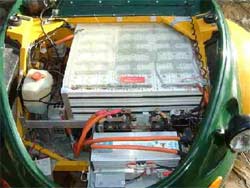Fraunhofer researchers have created a novel lithium-ion battery. It is based on a polymer electrolyte, which is – unlike the liquid electrolyte in conventional lithium-ion batteries – not inflammable. A test set-up for redox flow batteries will be on display at the Hannover Messe Show in Gernany show. This makes it possible to compare different redox systems in a single test set-up.
Lithium-ion batteries supply the power for cell phones and PDAs, and larger devices such as laptops, cordless screwdrivers and lawnmowers are becoming increasingly dependent on this power source. The advantage of these power storage devices lies in their high energy density and voltage (up to four volts). In terms of safety, however, they have one disadvantage – the organic electrolytes are flammable and can easily catch fire.
This has already resulted in several fires and subsequent recall campaigns. Researchers at the Fraunhofer Institute for Silicate Research ISC in Würzburg have optimized the safety of these batteries. “We have succeeded in replacing the inflammable organic electrolytes with a non-flammable polymer that retains its shape,” says ISC team leader Dr. Kai-Christian Möller.
“This considerably enhances the safety of lithium-ion batteries. What’s more, because it is a solid substance, the electrolyte cannot leak out of the battery.” The polymer used by the researchers is derived from the Ormocer® group of substances – a compound with silicon-oxygen chains that form an inorganic structure to which organic side chains become attached. The big challenge is to ensure that the polymers will efficiently conduct the lithium ions that supply the power for the cell phone and the PDA. “Normally, the more solid a polymer is, the less conductive it becomes. But we had numerous parameters that we could adjust – for example, we can use coupling elements with two, three or four arms. As a result, we have more possibilities with Ormocer®s than with a single type of plastic,” says Möller.
A prototype of the new lithium-ion batteries already exists, and the researchers will be presenting it at Hannover Messe (Hall 13, Stand E20). However, between three and five years are likely to elapse before the battery will cross shop counters in laptop computers, PDAs and cordless screwdrivers, the expert believes. The conductivity of the polymer needs further improvement to enable the battery to deliver or store as much power as possible in as short a time as possible. Once this happens, though, it is quite realistic to expect this type of battery – in conjunction with a capacitor – to be able to compete with the lead batteries in cars.
Redox flow batteries store solar energy Solar cells can be seen on the roofs of more and more houses today. The energy supplied by the sun and the wind is also increasingly being used on a large scale – in wind turbines and solar parks. But the energy supplied by the sun and the wind does not usually correspond to power requirements: On sunny days the solar cells often deliver more electricity than is needed, while solar energy may be in short supply when the sky is overcast. The amount of energy harvested from wind turbines fluctuates in a similar way.
In private solar energy plants, the surplus energy is stored in lead batteries until it is needed. The drawback of these storage systems is that they can only survive a limited number of cycles and normally have to be replaced after three to five years. In wind and solar parks, the energy is conserved by pumped storage plants. These, too, have a disadvantage: They have a relatively low rate of efficiency, which means that a lot of energy is lost. What is more, they take up a great deal of space. Redox flow batteries offer an alternative to lead batteries and pumped storage plants: They have a comparable energy density, but their service life is nearly ten times as long as that of lead batteries. So far, however, they are quite expensive in relation to their performance and energy density.
Researchers at the Fraunhofer Institute for Chemical Technology ICT in Pfinztal intend to change that situation in the years ahead: “We have developed the prototype of a redox flow battery that enables us to test various electrode materials, membranes and electrolytes as flexibly as possible,” reports ICT group leader Dr. Jens Tübke. “In this way, we can compare different redox systems in the same test set-up. This allows us to work out precisely what are the pros and cons of each system. It is not possible to compare the systems on the basis of existing documentation, as of course everyone measures them in a different test set-up.”

